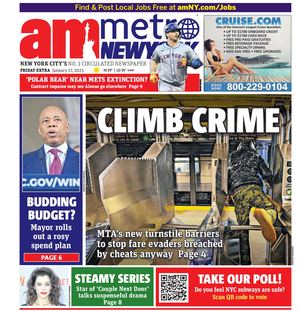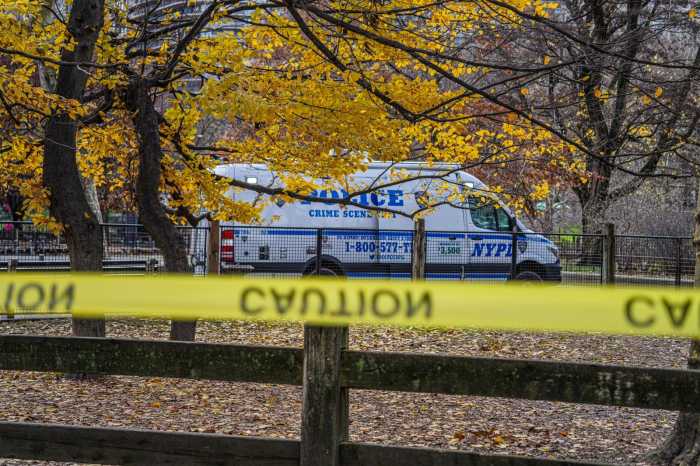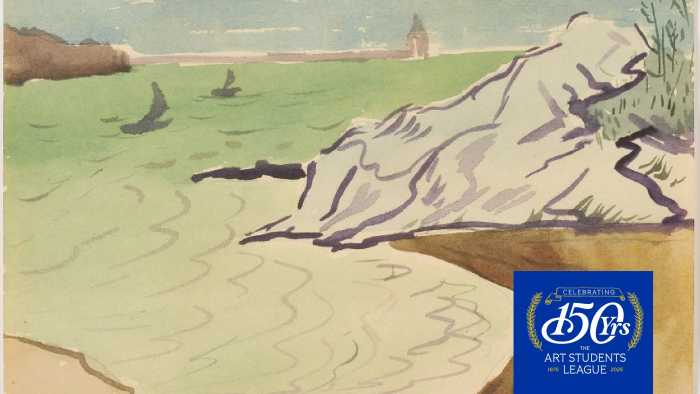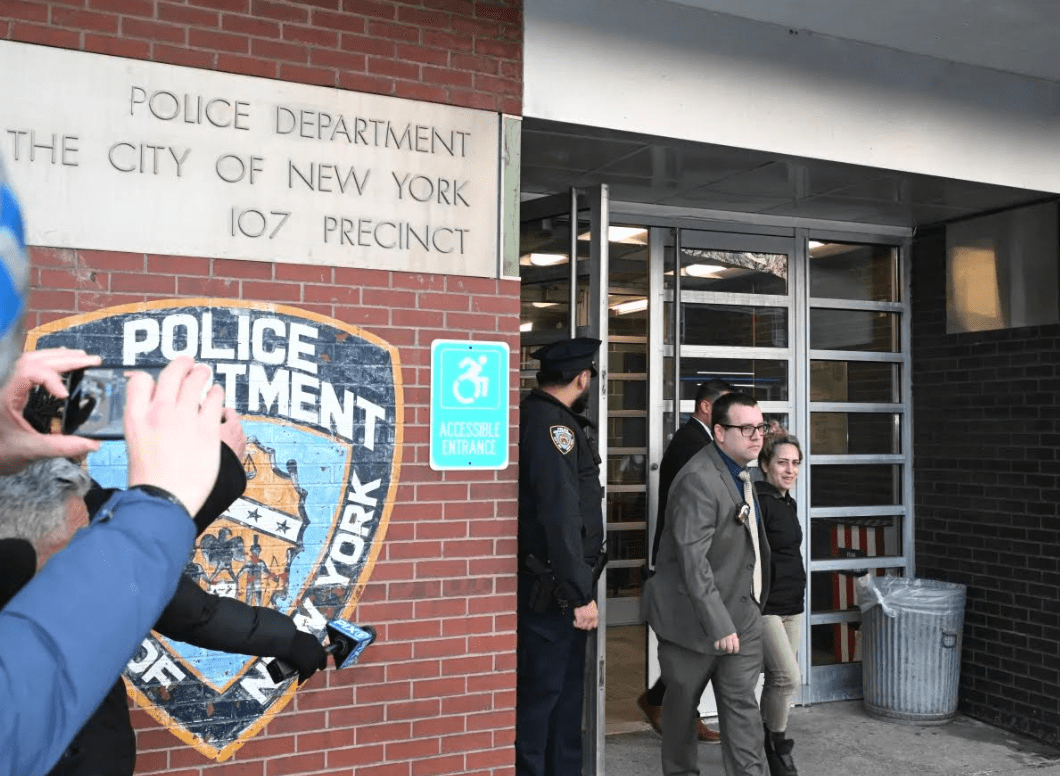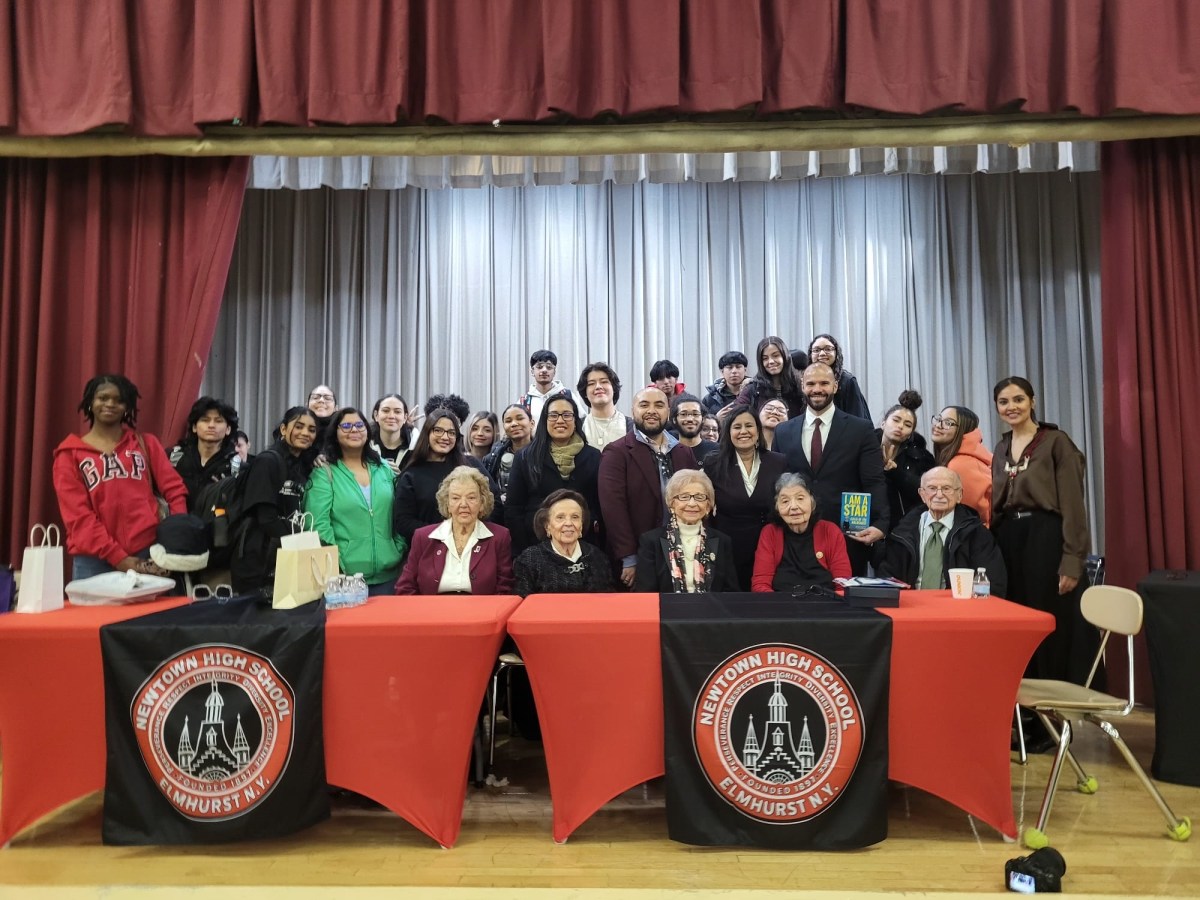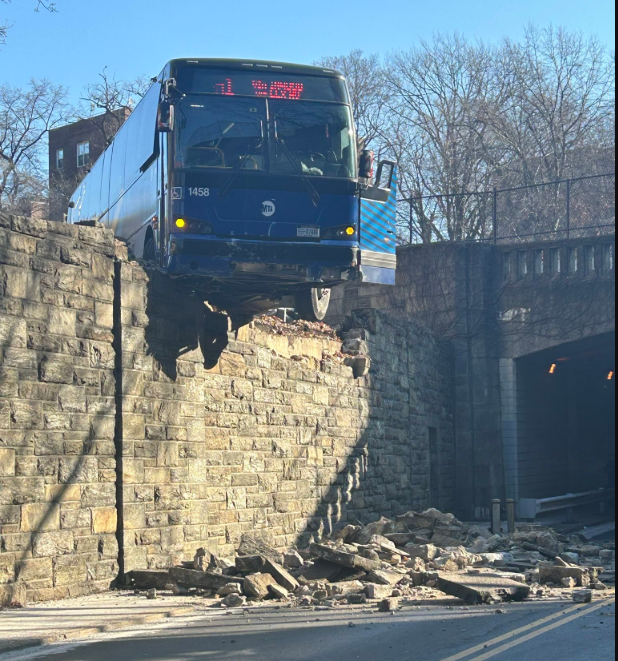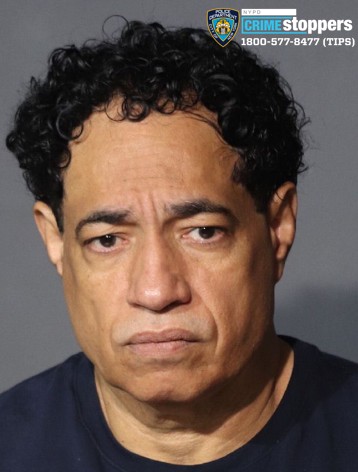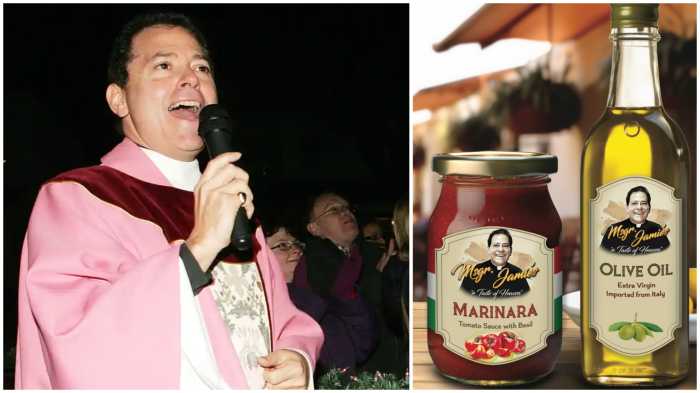By Lincoln Anderson
Volume 73, Number 24 | October 15 – 21, 2003
Did lawsuit threat force Trust to restart process on Pier 40?
The Friends of Hudson River Park weren’t so friendly last week and the get-tough approach just may have had the desired effect.
The waterfront park’s leading advocacy group, the Friends decided not to sue the Hudson River Park Trust over the recent failed Pier 40 process, instead using the threat of a lawsuit as leverage to try to restart the pier’s stalled development process.
According to Arthur Schwartz, a founder of Friends who would have been the lead attorney on the suit, the Trust, in return for the Friends not suing, has committed to issuing either a request for expressions of interest or request for proposals for developers for the 15-acre W. Houston St. Pier 40 by January.
The alleged agreement was said to be the result of a meeting last Tuesday between Douglas Durst, C.E.O. of Durst Organization and co-chairperson of the Friends, and Trip Dorkey, chairperson of the Trust’s board of directors.
However, Al Butzel, the Friends’ president, said the Trust didn’t commit to any date, but does plan to try to restart the Pier 40 development process as soon as possible.
In addition, the Trust reportedly agreed to call off a meeting scheduled for last Thursday at which its 13 board of directors members were expected to vote to approve an ice-skating rink near Spring St. in the park’s new Village segment.
A public hearing on the skating rink, led by Board 2’s Waterfront Committee, will now be held on Mon., Oct. 20, at 6:30 p.m. at the Manhattan Developmental Center, 75 Morton St.
Schwartz said Dorkey and Durst made a verbal agreement regarding the tradeoff of no lawsuit in return for the ice-rink review and restarting Pier 40’s process. Schwartz said he has no reason not to feel Dorkey will honor his word and issue either an R.F.E.I. or R.F.P. for the pier.
“If the [Trust’s] board abides by what [Dorkey] agreed to with Durst, then we’re back in the process — instead of seven or eight years [of interim uses on the pier],” Schwartz said.
Said Butzel: “The lawsuit wasn’t filed, because, first, they called off the meeting on the skating rink. [The rink] concerned us a lot. And we think there’ll be consideration of a new R.F.E.I. for Pier 40. We’re hoping there will be an R.F.P. because that’s more precise.”
An R.F.P. would contain more specific requirements for what the Trust wants to see at the pier, which, under the Hudson River Park Act, must be developed with at least 50 percent park and open space. The remaining 50 percent can be developed for commercial activity, the revenue from which will go to the park’s operating budget.
Both Schwartz and Butzel said they couldn’t speculate on which development groups might submit proposals for Pier 40 if the process is indeed restarted. Butzel said that if an R.F.P. is sent out in January, a developer could be in place in under a year, by next June or July.
However, the Trust is not confirming that Dorkey and Durst made any deal. Also, the Trust is denying the postponement of the ice-skating rink vote had anything to do with the Friends’ wanting it to have a public review first. At least, this much could be inferred from a two-sentence e-mail response to The Villager’s questions from Chris Martin, the Trust’s spokesperson, sent late yesterday afternoon.
TRUST’S DENIAL
Regarding the Trust’s allegedly committing to restart the Pier 40 process in return for the Friends dropping their lawsuit, Martin said, “The Trust has no knowledge of any such agreement.”
As to why the Trust board members’ scheduled vote was called off at the last moment, Martin said, “The meeting was postponed so that we could resolve some mechanical issues with the rink.”
Madelyn Wils, a board of directors member of the Trust, said she was hearing it first from The Villager that there had been a meeting between Dorkey and Durst. Asked if it was true that the Trust will move to revive the search for a developer for Pier 40, she said, “I’m not sure that’s totally accurate.”
As to why the ice-skating rink vote was delayed, Wils said, “[Assemblymember] Deborah Glick told me that changes to the park’s master plan need 30 days’ notice. I didn’t remember that. But she reminded people at the Trust.”
On June 10, just days before a legally stipulated deadline, the Trust decided not to pick a developer for Pier 40. In a press release, the Trust stated it was waiting for a better economic climate to undertake the costly and massive project.
The Trust has since moved forward with an interim plan for the pier, entailing adding 800 to 900 more parking spaces and possibly a large field in Pier 40’s inner courtyard. The Trust recently issued a request for proposals for a parking operator for the pier, with responses due Nov. 7. The contract for the parking operation is for four years, plus two one-year extensions.
Schwartz, a former chairperson of C.B. 2’s Waterfront Committee, said he had the lawsuit regarding the Pier 40 process written and ready to be filed Oct. 10. The suit’s main argument was that under an amendment to the Park Act, the Trust was required to expeditiously pick a developer for Pier 40 and then conduct negotiations towards developing the pier. However, the agency rejected the three remaining plans, including an aquarium and an arts complex, each with extensive rooftop sports-field space.
The suit on the failed Pier 40 process had to be filed by Oct. 10, since that’s when the four-month statute of limitations expired.
Schwartz said he already had several plaintiffs, including the National Resources Defense Council and Riverkeeper, in addition to the Friends, and that some block associations and individuals were also interested in being parties to the suit. Last Wednesday, Schwartz planned to attend a joint board of directors meeting of the Greenwich Village Little League and Downtown United Soccer League to see if they were interested in being plaintiffs, but was unable to attend for personal reasons.
ILLEGAL RINK VOTE
If the Trust had voted on the rink last Thursday it may well have violated the park’s governing law: Butzel referred to a section of the Park Act that states that whenever there is “any significant action affecting the park or community,” the Trust must hold a public hearing and give 30-day notice.
According to Butzel and Julie Nadel, a Trust board member, at the Trust board meeting scheduled for last Thursday, the directors were going to be asked to vote on an uncovered rink. Aversion of the rink unveiled on June 25 was covered by a permanent structure..
Said Nadel, “Any permanent installation that takes up a significant amount of space, covered or uncovered, is significant.”
Several individuals — Glick, Lawrence B. Goldberg, president of the Hudson River Park Advisory Council; and Nadel — lobbied Robert Balachandran, the Trust’s president, to postpone the vote on the rink until the community got a chance to review it and comment. Glick, like Butzel, said a vote by the Trust’s board would have violated the Park Act.
Glick additionally faxed a letter to Dorkey, calling the rink proposal “a most distressing turn of events.”
Wrote Glick: “It’s shocking that in all discussions regarding Pier 40 [which the rink would be located just south of], there was no mention that the Trust staff was proceeding so quickly with construction of an unannounced and undiscussed plan for this facility. I am asking you to put off any vote on this plan…and to delay it until the Trust acts within its mandate to consult with Community Board 2 and the larger community.”
The Oct. 20 public hearing on the rink to be held by C.B. 2’s Waterfront Committee was announced by a C.B. 2 press release sent out at 1 p.m. last Thursday, about four hours after the e-mail announcing the Trust’s board vote on the rink had been cancelled. Trust officials will be present at the Oct. 20 meeting to answer questions from the community, and comments will be welcomed.
Don MacPherson, chairperson of C.B. 2’s Waterfront Committee, said both Balachandran and Fishman, the Trust’s vice president, reached out to him regarding holding a public hearing on the rink, which he called a “positive step.”
In addition, the Pier 40 Committee — a group composed of members from Community Boards 1,2 and 4, created to review the Trust’s Pier 40 interim plan — held its first meeting last Wednesday. Balachandran and Fishman both attended. Although Trust spokesperson Martin last month said one huge multi-use sports field will likely be located in the pier’s courtyard under the interim Pier 40 plan, according to Nadel, at last Wednesday’s meeting, Balachandran was less specific on where the interim fields will go, indicating to her that perhaps they might not be in the courtyard.
PIER 40
Yet, both Friends president Butzel and attorney Schwartz said, at this point, they oppose the interim development of the pier.
The main fear of the Friends, laid out in a letter to the Trust following its failure to pick a developer, is that interim development will become the de facto final development, adding uses that will be hard to get off the pier once in place. Even adding 100 more parking spaces is a concern, Butzel said.
“I think that anything that commits the pier for more than a year at a time is a concern,” he said. “It’s not that it’s hard to get [interim uses] off, it’s that it’s hard to [interest] a developer for the full pier” if the pier has interim uses. Under the Park Act, current commercial tenants other than residential parking, such as FedEx and Academy Bus, must vacate the facility by year’s end.
Schwartz said it’s not clear if the agreement means the Trust will now scrap its interim plans for the pier, but he said if the Trust proceeds with an interim plan that ties up the pier for severak years, it raises the same issues in the Friends’ withdrawn lawsuit — that the Trust is not moving expeditiously to redevelop the pier.
“Building structures and putting down a field, that’s not an interim plan, that’s a long-term plan,” Schwartz said. “And seven or eight years [with an interim plan] could easily turn into 20.”
In addition, Schwartz pointed out that if the Trust can survive on the $5 million a year in revenue the parking generates for seven years under an interim plan, why is it even necessary to consider large-scale commercial development for the pier? The Hudson River Park is the first park in New York State history that is supposed to be self-supporting, with a projected annual operating budget of $12 million.
Also, noting that the small existing field on the corner of Pier 40’s roof cost $2.5 million, Schwartz said the estimated more than $5 million cost of building an interim courtyard field should be instead put towards the cost of the pier’s full redevelopment.
HOW DO LEGALS FEEL?
But how will the youth sports leagues feel about not getting a coveted interim field by the spring? Butzel noted that in the last round of developers’ proposals for Pier 40, the projects all included large sports fields on a rooftop park.
“The goal is to get fields on top, not in the center [of the pier],” he noted.
Barry Lafer, president of the Greenwich Village Little League, said G.V.L.L. and Downtown United Soccer Club are willing to wait, up to a point, for the pier’s redevelopment, but that they don’t want a repeat of the recent failed Pier 40 process. He said the leagues weren’t sure that joining the lawsuit was the right thing to do, plus Schwartz sought to approach them very late, right before the statute of limitations to sue was set to expire.
“I’m not convinced one way or another whether the interim [plan] is good or bad,” Lafer said. “I want something for the community, I want a great park, but I represent the interests of the leagues. I’m not going to be pleased if we go through this thing and another year goes by and they come back and say, ‘No developer.’ If there’s some document that lays out exactly what the Trust is committing to, I’d be interested in seeing that.”
But Tobi Bergman, president of Pier, Park and Playground Association and a Friends board member, strongly supports building the interim fields now and waiting awhile before issuing another R.F.P.
“There’s no point in having another R.F.P. unless something changes,” said Bergman, a former G.V.L.L. president. “The process didn’t succeed. The right project didn’t come forward…. The Trust has promised interim uses and they should provide it. I think there would be a lot of people who will be very happy with the sports and passive recreation uses on the pier…. [The interim uses will] give time to breathe. To start a new process in three months, you haven’t dealt with the reasons why it failed the first time. I think it’s going to take longer than that to get a meaningful process going. You can force a process, but you can’t force it to be successful.”
Bergman said when the right project comes along that everyone can support, the interim uses will get off the pier.
Trust board member Wils also indicated that she personally is not a fan of interim uses on the pier, though she said it’s for the public to decide.
“We have to keep all our options open,” she said. “From a personal point of view, I would not like to see a lot of public money spent on [interim public recreation uses on the pier]. I would like to see us go forward with an R.F.P. as soon as it makes sense.”
But Wils said they want to avoid the meltdown that occurred with the Pier 40 process last time.
“I think it will take a little more work to put out a good R.F.P.,” she said. “We need to do a little more homework.”
Reader Services
